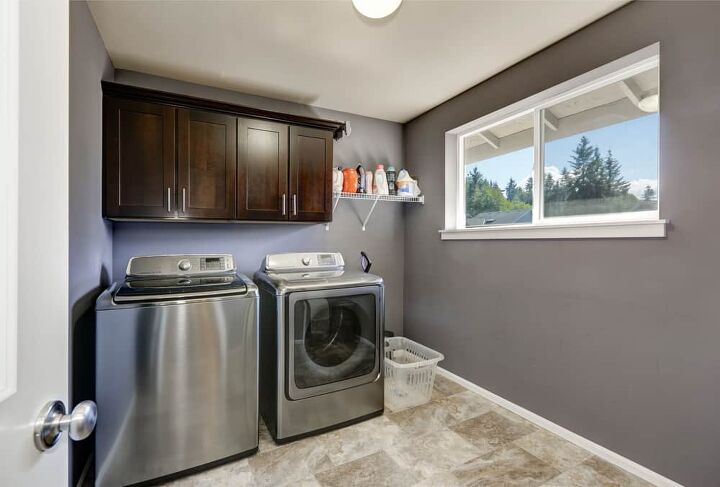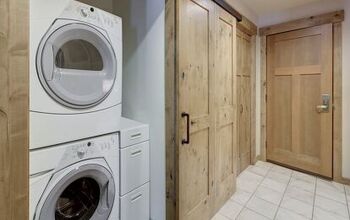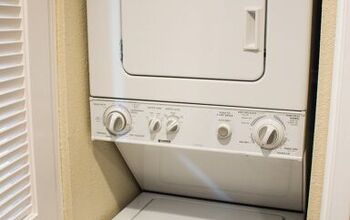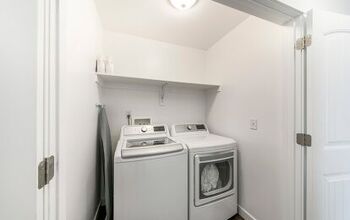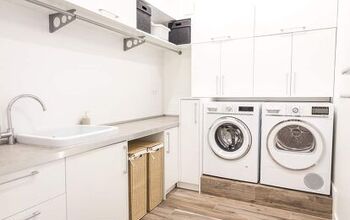Standard Washer and Dryer Dimensions (with Photos)

You might not like doing laundry, but it’s pretty much a fact of life that it has to get done. No matter what your laundry needs, you have to pick the washer and dryer that will work best for you. Obviously, your appliances need to fit in your laundry area, but the inside dimensions play a big role in performance.
Typical washers and dryers are 27 inches wide, 31 to 33 inches deep, and between 36 and 39 inches tall. However, the capacity of the machines is also a critical factor to consider when selecting your appliances. Washing machines range from 2.3 to 5.0 cubic feet, with the average being 3.5; a dryer’s capacity is typically larger.
Do You Need Appliance Installation or Replacement?
Get free, zero-commitment quotes from pro contractors near you.

Standard Dimensions of a Washing Machine
A washing machine’s average size is roughly 27 inches wide x 31 inches deep x 39 inches tall.
However, there are models that are taller but shallower if you have a smaller footprint for your machine. For example, a washing machine could be closer to 28 inches deep, but it has a height of 42 inches.
The interior space of a washing machine also varies from unit to unit. However, the average capacity is 3.5 cubic feet. This measurement is critical when choosing your machine, especially if you plan to wash overly bulky items.
For example, some large machine-washable products, like 8 x 10 Ruggables, require a larger washing tub. Ruggable specifies that you need at least a 3.5 cu. ft. machine to wash its 8 x 10 rugs.
If you routinely wash large loads of laundry, then you might want to consider an extra-large capacity machine. Opting for a 4.2 or 5.0 cubic feet washer can drastically cut down on your number of loads.
How Much Wash Can a Washer Wash?
It might sound like a tongue twister, but it’s a vital question when it comes to selecting your washing machine. On average, a typical washer, between 3.2 and 4.0 cubic feet, handles about 12 to 16 pounds of laundry. Alternatively, a larger capacity washer, closer to 4.2 to 5.0 cubic feet, can handle 20 pounds or more.
Standard Dimensions of a Dryer
A dryer is usually slightly larger than a washing machine, at least in terms of capacity. This extra space is because clothes and other items tend to fluff up in the dryer, taking up more space.
A typical dryer is approximately 27 inches wide, 26 to 29 inches deep, and between 39 and 42 inches tall. This height includes the control board and is similar for both gas and electric models. For the most part, a dryer will have the same height and depth as its matching washer.
These dimensions usually match since these appliances are typically designed to stand side-by-side. However, the width of each machine can sometimes vary, especially since the dryer’s capacity is normally larger.
A standard dryer has an average capacity of about 6 cubic feet. A large-capacity dryer has closer to 7.5 cu. ft. and an extra-large dryer can be over 9 cu. ft.
The larger the capacity of the dryer, the larger the exterior dimensions. When purchasing a washer and dryer set, the dryer will usually feature double the capacity of its matching washing machine.
Dryer Vent
When considering the space for your dryer, don’t forget to account for the venting. Standard dryers need an exhaust vent to send heat and moisture outside of the house. The ductwork should be kept to a minimum, as too much can affect your dryer’s performance.
Keep the overall length of your dryer duct run to less than 60 feet. Also, ensure there are minimal turns and bends. Plus, leave between 3 and 5 inches behind your dryer for hook-ups and venting.
Front-Load Washer and Dryer Dimensions
If you opt for front-load machines, don’t forget to account for enough space in front of your appliances. You need enough clearance to open the door of the machine completely. Plus, you want adequate space to load and unload the machines comfortably.
The door of a dryer or washing machine takes up about 22 to 23 inches when open. In addition to this space, you also want to account for any additional space you need to maneuver around.
Though, in general, front-load washers are dryers come in the most diverse array of sizes. They can be grouped into three main categories: compact, full-size, and mega-capacity. The following table outlines some standard dimensions for each of these types of front-load washers and dryers:
Dimensions of Front-Load Washers and Dryers| Compact | Full-Size | Mega-Capacity | |
| Height | 34 inches | 39 inches | 40 to 42 inches |
| Width | 24 inches | 27 inches | 28 to 30 inches |
| Depth (door closed) | 24 inches* | 32 to 34 inches* | 32 to 34 inches* |
| Depth (door open) | 42 to 44 inches* | 54 to 57 inches* | 55 to 56 inches* |
*measurement does not include standard 4-inch venting
Top-Load Washer Dimensions
While accounting for clearance in front of your machine for your dryer door, don’t forget about your top-load washer. If you load your machine from the top, the last thing you want is the lid falling on you. You also don’t want to end up doing laundry one-handed because your other hand is holding up the washer lid.
Top-load washing machines are typically considered an entry-level laundry appliance, and most are familiar with how to operate them. Overall, the lid is the biggest consideration, which will be limited based on overhead cabinetry. The standard dimensions for top-load washers are as follows:
- Width: 27-28 inches
- Height: 44 inches
- Depth: 26-28 inches
However, these measurements do not include the additional four inches for connections. With the lid open to about 90 degrees, top-load washers fall between 52 inches to 58 inches total in height. Ensure there is enough clearance above your top-load washer for the lid to open fully and remain open without assistance. Since it’s also good to keep the washer lid (or door) open after a wash, this makes things much simpler.
When it comes to top-loading dryers, you can basically pair any dryer with your top-load washer. The standard dimensions for top-load dryers are very similar to their top-load washer counterparts:
- Width: 27 inches
- Height: 41 to 44 inches
- Depth: 26-32 inches
These measurements also do not include the additional four inches for connections and with the door open a full 90 degrees, the depth becomes between 42 and 58 inches.
Stackable Washer and Dryer Dimensions
If your laundry area is short on space, you might want to opt for a stacking system. Stacking two units cuts down on the overall footprint of your machines. You only need about half the width of space, but of course, double the height.
Therefore, if you decide to get stacking units, make sure you have plenty of vertical clearance. Some units are designed to only stack and cannot be used any other way.
Other front-load systems can stack on top of each other with the appropriate stacking kit. When you purchase your machines, if you plan to stack them, get the kit at the same time.
Washers and Dryers with a Smaller Footprint
If you have very limited space to do laundry, don’t worry, you’re not destined for multiple trips to the laundromat. There are a few options at your disposal, including all-in-one units or compact units. These appliances are ideal for small living spaces, tiny houses, and RVs.
All-in-One Combo Washer and Dryer
These types of appliances are both a washer and dryer in one, pulling double duty in less space. These units can often be the size of either a full washer or dryer, but you just need one. There are also smaller units that measure closer to 24 inches wide x 25 inches deep and 33 inches tall.
Compact Washers and Dryers
Compact washers and dryers, like the name implies, are smaller than standard laundry appliances. They range from between 24 and 27 inches wide and are about 34 inches high.
On average, these compact machines are about 23 inches deep, and the dryers are typically only available in electric models. To take up even less floor space, you can also purchase these compact units as stackable systems.
Space Needed for a Basic Laundry Room
The most significant factor when choosing your appliances is the size of your designated laundry space. Of course, performance, efficiency, and cost are important, but won’t do you much good if your appliances can’t fit.
You might have a separate laundry room, or you might have a laundry closet. Either way, you can make these spaces work with the right size machines.
Laundry Closet
To accommodate a side-by-side washer and a dryer an ideal minimum closet width is five feet. This measurement provides adequate space for both units and some storage.
A standard washer and dryer take up roughly 54 inches when side-by-side. Therefore, a minimum width of 60 inches provides ample room for both appliances and space to work.
If your laundry closet is less than 60 inches wide, then opt for a stacking system. A stackable system averages 27 inches wide, making even a 3-foot closet workable, as long as you have the height. Of course, you could also opt for a combo unit in this smaller footprint as well.
Laundry Room
Laundry rooms can be small to grand, but a basic laundry room is about 5 x 6 feet. This provides adequate space for both units, storage, hook-ups, and moving around the area.
You can use stacking units in a laundry room to free up more floor space or create more reachable storage. You can also opt for smaller units if your laundry area is a smaller size. Just remember to get the right size machines for the amount of laundry you do.
Do You Need Appliance Installation or Replacement?
Get free, zero-commitment quotes from pro contractors near you.

Related Questions
How much space does the agitator take up in a washing machine?
The agitator is the spindle that sticks up in the middle of the washing machine tub. Some machines don’t have an agitator, and instead, have a small hub called an impeller. If your machine has an agitator, it will hold slightly less than an impeller machine of the same size. Although agitator machines were once on the smaller side, you can now get extra-large capacity models up to 6 cu. ft. The most important thing to remember is to not overload your machine, even without an agitator. Clothes need room to move freely to get cleaned thoroughly.
How do washer and dryer pedestals affect the dimensions of the appliances?
If you need extra storage space in your laundry area, pedestals under front-load machines can offer a solution. However, keep in mind they’ll give your appliances a boost, raising the height up to 15 inches. This extra height can make loading these machines easier. However, remember to account for the raised height when planning any storage areas above your machines.

Stacy Randall is a wife, mother, and freelance writer from NOLA that has always had a love for DIY projects, home organization, and making spaces beautiful. Together with her husband, she has been spending the last several years lovingly renovating her grandparent's former home, making it their own and learning a lot about life along the way.
More by Stacy Randall



